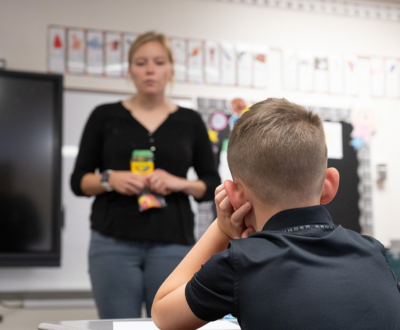
Formative assessments impact instruction directly. When teachers use formative instructional practices, they assess students, interpret results, and respond. Tools and strategies for formative assessments range from just noticing students who look frustrated to exit tickets, polls, surveys, and quizzes. These practices happen independently in classrooms, isolated from other classrooms. For this reason, some would argue that there really cannot be a common formative assessment, because teachers conduct formative assessment on their own in their own classrooms.
“When the results of common assessments inform decisions that help coordinate a group’s instructional actions, a common assessment becomes a common formative assessment.”
For a common assessment to be a common formative assessment, the information from the assessment needs to be used collaboratively. When the results of common assessments inform decisions that help coordinate a group’s instructional actions, a common assessment becomes a common formative assessment. In practice, this could look like planning a series of number talks together. Alternatively, teachers could work with small groups of students for targeted interventions, using a shared learning goal based on that assessment’s results. In other words, common formative assessments exist when teams of teachers use assessment results to collectively plan and respond.
Formative assessments versus summative assessments
A summative assessment sums up the learning from a sequence of lessons. Additionally, summative assessments inform reporting, including grades.
If the information from the “summative” assessment informs instructional responses, then the summative assessment is also a formative assessment. Does the assessment help identify areas for reteaching, review, or make grouping decisions? If so, an end-of-unit test is summative, and as its results inform instruction, it is also formative. Many “summative” assessments can also be considered formative assessments.
Adopting common formative assessments for your team
Common formative assessments are a critical tool for school improvement. Unfortunately, they are a practice and not a product. They cannot be bought or downloaded. Your school or district may purchase curriculum with formative assessments or adopt formative assessment tools to facilitate the collection and analysis of formative assessment. Nonetheless, if that information does not inform instruction, then “formative” assessments are no longer formative.
“Formative assessments are a practice, a way of thinking and responding to student learning, rather than a product.”
To adopt common formative assessment practices, leaders need to foster formative instructional practices across schools. They need to provide teachers with time both for independent planning and collaborative meetings. In this way, formative assessments are a practice, a way of thinking and responding to student learning, rather than a product.
District-wide common formative assessments
If common formative assessments exist, can a district scale this practice across buildings district-wide? No. Teams of teachers implement common formative assessments, often led by a coach or a principal. It is not possible to scale this to a district-wide implementation by district leadership. These efforts need to be led by teachers. It can be hard if not impossible to coordinate this ongoing collaborative work across districts, particularly large districts. In sum, formative assessment is a classroom up rather than district or top-down initiative.
Conclusion
Common formative assessments can exist across grade-level teams in a building. They exist when teachers collaboratively share, analyze, and respond to student learning. Although critical to school improvement efforts, these practices cannot be scaled district-wide. This is because teachers bring essential voices to analyzing and responding to student work. District and building leaders should not just seek to purchase a product or adopt a new tool. Instead, they should help foster cultures embracing formative instructional practices. These changes will lead to working cultures that are much more effective at supporting student learning.
About us and this blog
Our team and tools help schools implement standards-based grading, streamline assessment systems, and use meaningful data to drive decision-making.









